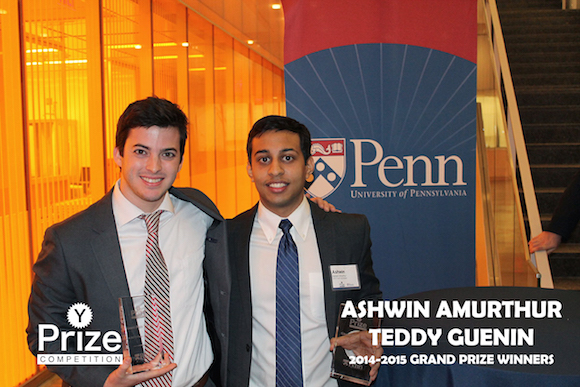Last week, we took a look at how the graphene technology developed at the University of Pennsylvania is shaping the global marketplace, and now, a pair of Penn students has won the annual Y-Prize contest for applying this rapidly-growing field to the problems of fracking.
Winners Ashwin Amurthur and Teddy Guenin are both fourth-year students of dual-degree programs at Penn Engineering and the Wharton School. Guenin, a Lancaster native, is doing his undergrad work in bioengineering, marketing and management, with a master’s in mechanical engineering on deck after that, and Amurthur, from Princeton Junction, N.J., is majoring in bioengineering and finance.
This year, the Y-Prize contest invited students to develop a new application for existing Penn nanotechnology, and drew a record 19 entries. Four finalists presented their concepts to a panel of judges on January 28, and Guenin and Amurthur nabbed the $5,000 first prize. The funds aren't the only reward: they also receive the framework for a non-exclusive license to the Penn technology, an important first step in commercializing their proposal.
Guenin says the controversy of natural gas drilling's environmental effects loomed large as he grew up in central Pennsylvania. Together, the young men have applied Penn’s graphene field-effect transistor (GFET) technology to the detection of benzene in groundwater.
Currently, drilling companies who suspect leaks in the underground casings of their equipment — and local governments and consumers worried about water contamination — don’t have a reliable way to confirm and pinpoint those leaks. Groundwater can be tested for levels of various chemical ions and compounds like chlorides, but since these can occur naturally in some water samples regardless of the side-effects of fracking, the tests don’t offer conclusive answers.
“The oil companies want to know for sure, do we have a leak or not?” Amurthur explains.
The Y-Prize team’s answer is GFETs for detecting benzene, a carcinogenic compound used in fracking fluid that usually does not occur in groundwater naturally.
If the team can develop their benzene GFETs and bring them to market, “you could more conclusively say that you do have a leak,” Amurthur continues. It’s vital information for municipalities, drilling companies and consumers alike, and could ensure more rapid and accurate repair of leaking casings, enhanced safety, increased profits and a protected environment.
Though there’s a lot of work yet to be done to bring this concept to market, Guenin is excited about the opportunities for networking and the support the Y-Prize win will bring.
“It’s awesome that we were able to get this,” he says. “And we’re really really excited to move forward with it.”
Writer: Alaina Mabaso
Sources: Ashwin Amurthur and Teddy Guenin, GFET-Frack Technologies
